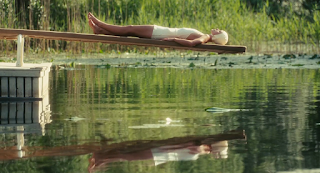Este post foi escrito para a série Hit Me With Your Best Shot do blogue The Film Experience de Nathaniel Rogers, sendo que é aqui apresentado em inglês, ao invés do que é usual neste blogue.
Let me tell
you something. Despite having only started participating in this series last
year, I’ve been following The Film Experience’s Hit Me With Your Best Shot
since its first season and I’ve mostly tried to watch all the films that were
featured in it. Consequently I had to suffer through some bad ones like 1966’s Batman,
Mommie
Dearest, Can’t Stop the Music, Barbarella and Showgirls. None of them were
as difficult to watch as the cinematic catastrophe that is John Boorman’s
1974’s attempt at making a low-budget sci-fi epic, Zardoz. Some of those
previous works were intelligently subversive in their mainstream movie
incompetence, while others were stupidly terrible and amazingly fun to watch. Zardoz
isn’t intelligent and it certainly isn’t fun.
The film
follows Z, an Exterminator in a post-apocalyptic future, whose purpose in life
seems to be simply to kill everyone in sight, at the orders of a god, called
Zardoz, that manifests itself in the form of a giant flying stone head. One
day, he enters the monumental statue, and is transported to the Vortex, a place
where life still seems to thrive, unlike the barren land he inhabits, and where
the Eternals live. From then on, the film explores the way in which eternal
life might perniciously affect humanity, as well as constructing around Z a somewhat
classic narrative of a messianic chosen one that is there to save the human
species gone astray because of their unnatural hubris. Only instead of love,
Z’s gift to humanity is hatred, violence, death and sex.
Zardoz is, as many of its defender’s claim,
an ambitious project full of ideas. I have to agree with this, but I must also
add that ambition doesn’t necessarily imply quality, and that while it may be
full of ideas, they’re often offensive and juvenile, if not downright stupid. Despite
that, the main problem is the way in which it seems everyone involved in the
project made it with the sincere belief that they were creating a deep, thoughtful
and insightful work of art with meaning and importance. The result is a joyless
mountain of suffocating pretentiousness, the likes of which are usually exclusive
of Philosophy students’ drunken ramblings on their first year of college.
The tragedy
of all of this is the fact that most of the people involved in Zardoz
aren’t particularly untalented. After all, John Boorman is the man that
directed Excalibur, Geoffrey Unsworth shot Kubrick’s 2001
and Charlotte Rampling is a goddess of screen acting, just to name a few.
Consequently, despite its abject stupidity, its invariable joylessness and its soporific
rhythm, Zardoz is full of surprisingly enticing images. Therefore,
picking a “best shot” was much more difficult than I was originally expecting.
For a
while, I was thinking of choosing a shot from one of the film’s best sequences.
One of them is its ironic introduction that features two ridiculous floating
heads, the immortal line “guns are good, the penis is evil” followed by a waterfall
of guns being vomited out of a giant stone mouth, and Sean Connery shooting the
camera, in a vain attempt to destroy the film before it can go on or to kill
the audience in an act of mercy.
The second
sequence that captured my attention was the film’s most widely celebrated one,
where our protagonist is gifted with humanity’s knowledge and history in a
psychedelic sequence that utilizes naked bodies and projections. The technique
reminded me of some of James Bond’s best intros and thus transported my mind to
a much happier place than Zardoz.
Thirdly,
there’s the scene where Boorman decides he’s going to make an homage to Welles’
Lady
from Shanghai, peppered with some hilarious visual details like Sean
Connery’s red high-heeled shoes that are probably there to give us another
reference to The Wizard of Oz. Sean Connery as Judy Garland mixed with Rita
Hayworth, who would have thought?
Quickly I
rejected the idea of picking a shot from the film’s best scenes. After all,
they almost suggest a mildly amusing experience, and Zardoz is anything but.
My next possible choice came in the form of the film’s most hilarious moment,
where Boorman constructs an entire scene around his protagonists’ capability to
have an erection, which is prompted by the cold magnificence of Rampling’s
Consuela rather than an array of pornography he’s showed. There’s no other
scene that better encapsulates the film’s relationship to sex. Unerotic, cold,
ridiculous and terribly juvenile.
Alas, that
didn’t completely satisfy my snarky intentions. So we come to my best shot and
runner-up.








































